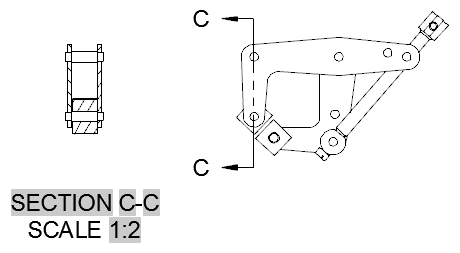A model documentation section view is a projected view from an existing drawing view, where you use a section line to cut through the drawing view in order to reveal what is inside.
The illustrations below show the different entities generated by the VIEWSECTION command, and the terms used to refer to them. Section view styles control the appearance of each of the listed entities.

Constraining Section Lines
If infer constraints are turned on (CONSTRAINTINFER=1) at the time you create the section view, constraints are inferred between the view geometry and the section line. When view updates take place, the constraints ensure that the section line retains its position in relation to the features it highlights. In some cases, you may require constraints that are more complex than the inferred constraints. For example, a section line that must pass through 15 mm from a given edge. In such cases you can manually constrain the section line to the view geometry, using a special edit environment known as the "symbol sketch mode". The sketch mode allows you to add additional geometry to assist you constrain the section line. This geometry is considered construction geometry and is visible, only in symbol sketch mode.
Component Participation in Section Views
Components cut by the section line are hatched in the section view. Mechanical engineering drafting practices demand that components such as fasteners and shafts must not be hatched (sectioned).

Accordingly, the VIEWSECTION command detects Inventor content library components and does not section them. However, AutoCAD 3D models do not contain metadata to explicitly identify components such as shafts or fasteners. Hence, you must manually select such components and exclude them from being sectioned.
Projecting Views from Section Views
Like from any other drawing view, you can generate projected views from a section view. However, only isometric projected views inherit the cut, by default. Orthogonal projected views do not inherit the cut. As such, the orthogonal projected view of a section view is a complete view.

Isometric projected views of a section view are not controlled by section view styles. Instead, they inherit properties such as scale and hatch properties from the parent section view.